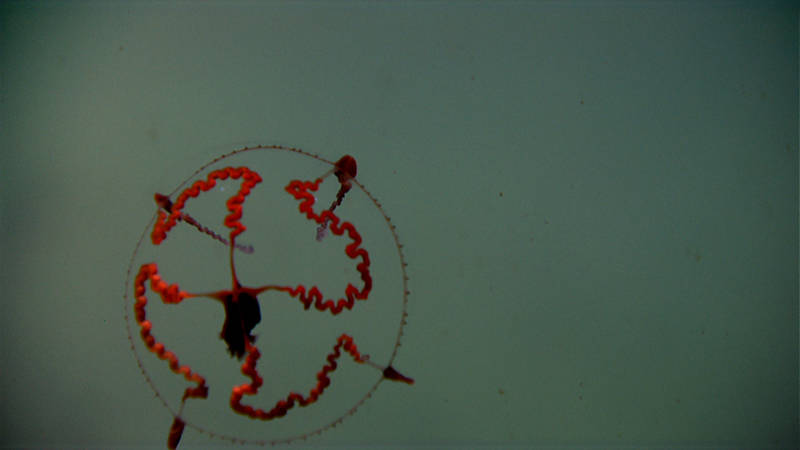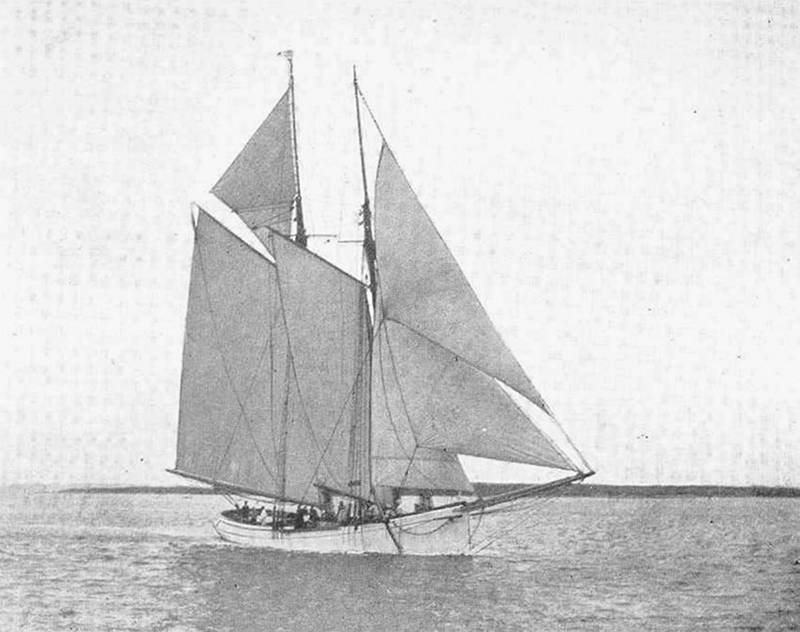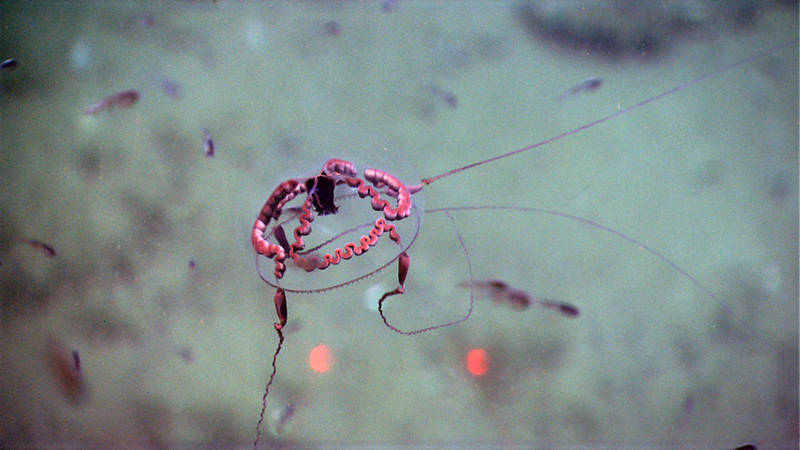
By Allen Collins - National Systematic Laboratory of NOAA’s Fisheries, housed at Smithsonian National Museum of Natural History
Mike Ford - NOAA National Marine Fisheries Service
September 27, 2014
During Dive 2 of the second leg of Our Deepwater Backyard: Exploring Atlantic Canyons and Seamounts expedition, remotely operated vehicle (ROV) Deep Discoverer (D2) encountered two jellyfish. Unfortunately, none of the scientists watching the dive live specialized in water column life. However, Okeanos Explorer does partner with a number of midwater specialists, such as ourselves, who sometimes join the dive for the vehicle's descent and ascent, to observe and describe animals that live in the water column.

A nice topside view of the bell of C. welshi. Image courtesy of the NOAA Office of Ocean Exploration and Research, Exploring Atlantic Canyons and Seamounts 2014. Download larger version (jpg, 1.3 MB).
While neither of us was following the dive at the time, after the image of the striking jellyfish was shared on the NOAA Office of Ocean Exploration and Research Facebook page, we both independently saw it.
It was immediately recognizable as a hydromedusa (jellyfish of the class Hydrozoa) in the order Leptothecata due to the fact that its gonads were running along the radial canals, which run from the central stomach along the bell toward its edge. Indeed, it is these radial canals which gave the animals their unusual appearance. In most jellyfish, the radial canals are straight, but these have a long elegant S-shape.

The schooner, Grampus Download image (jpg, 56 KB).
After a little digging, one of us (Dr. Collins) was extremely excited to find a discussion and original description of this hydromedusa in Henry B. Bigelow’s 1918 publication, ‘Some Medusae and Siphonophorae from the Western Atlantic ![]() .’
.’
In this paper, the hydromedusa was described from two specimens, the first with a 4.9-centimeter diameter bell and another with a 6.8-centimeter bell diameter. It was declared a new species, Cyclocanna welshi.
The samples were found by Bigelow aboard the U.S. Fisheries Commission schooner Grampus on August 16, 1916, at a depth of 140 meters while working off the coast of Virginia. Bigelow (the same Bigelow famous in fisheries science and whose name appears on the side of one of NOAA’s newest research vessels) describes the peculiar medusa with obvious S-shaped radial canals and gonads running along the inside of the bell. It is this structure and a few other physical characteristics that helped Dr. Collins to identify this unique and seldom seen hydromedusa.
Our hydromedusae were observed at approximately 650 meters by ROV Deep Discoverer in Washington Canyon, a dive site 53.7 nautical miles off the shores of Assateague Island National Seashore in Maryland and just 4.1 nautical miles from the site of Bigelow’s sample. As with all video collected by Okeanos Explorer, the video of the hydromedusae were instantly available to us as part of the shore-based science team. The images captured our curiosity and we were able to immediately begin the process of identification, through observation of physical characteristics (color, position of gonads, numbers of tentacles, etc.) and reference to taxonomic literature held by experts.

Here you can see some of the diagnostic features of C. welshi, like the S-shaped radial canals and gonads running along the inside of the bell. The red dots in the background are 10 centimeters apart and are used for scaling. Image courtesy of the NOAA Office of Ocean Exploration and Research, Exploring Atlantic Canyons and Seamounts 2014. Download larger version (jpg, 2.0 MB).
Characteristics of the bell, stomach, internal canals, tentacle number, and shape are all considered to help narrow down to one of the species identified in a stack of published literature. While having a specimen in the lab to establish a collection that can be used to monitor changes within species over time and use many new genetic techniques would have been great, this video sample was useful to note the species at this location. In fact, our hydromedusae were seen at depths much greater than Bigelow’s, which expands our understanding and generates new questions.
Many species of small medusa not so unlike the C. welshi found by D2 are found in all the oceans. At times, the populations of gelatinous animals are obvious to us when we see dense blooms preventing recreational activities at the beach and fishing operations off the coast. However, we are learning more about the "baseline" of gelatinous species that might not bloom to such densities, but live in the midwater depths on the continental shelf and in the open ocean.
We are asking questions about the relationship of these organisms to the rest of the ocean ecology. How many are there? Where do they sit in the food web? Do they have the potential to bloom and disrupt swimming and fishing?
High-definition video sampling conducted off platforms like D2 let us identify and count organisms that have in the past been destroyed by net collection or out of reach of routine surveys.